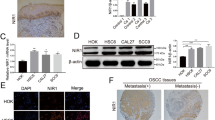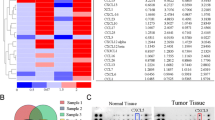Abstract
Oral carcinogenesis is a multistep process and requires accumulation and interplay of a series of molecular events. Chemokines and their receptors have been suggested to play important roles in the initiation or progression of cancers. Until now, no report focuses on their alterations in premalignant stage of oral squamous cell carcinoma (OSCC). Compared with normal tissues, mRNA levels of 9 chemokines and 3 chemokine receptors including CXCR7 in oral leukoplakia (OLK) were increased more than two folds by microarray analysis. Then, CXCR7 was selected for further confirmation and immunohistochemistry examination during multistage oral carcinogenesis. CXCR7 was expressed in 85% of OLK and 86% of OSCC. However, only 8% (1 of 13 cases) of normal tissue displayed CXCR7 immunostaining. The positive ratios of CXCR7, CXCL12 and CXCL11 in OLK and OSCC tissues respectively, were significantly higher than that in normal epithelia (P < 0.05), although no significant difference was found between OLK and OSCC. Meanwhile, CXCR7 always concomitantly expressed with it ligands in OLK and OSCC tissues. Our results indicated that CXCR7-CXCL12/CXCL11 axis might play important roles in oral carcinogenesis.




Similar content being viewed by others
References
Burns JM, Summers BC, Wang Y, Melikian A, Berahovich R, Miao Z, Penfold ME, Sunshine MJ, Littman DR, Kuo CJ, Wei K, McMaster BE, Wright K, Howard MC, Schall TJ (2006) A novel chemokine receptor for SDF-1 and I-TAC involved in cell survival, cell adhesion, and tumor development. J Exp Med 203:2201–2213
Chuang JY, Yang WH, Chen HT, Huang CY, Tan TW, Lin YT, Hsu CJ, Fong YC, Tang CH (2009) CCL5/CCR5 axis promotes the motility of human oral cancer cells. J Cell Physiol 220:418–426
Falleni M, Pellegrini C, Marchetti A, Oprandi B, Buttitta F, Barassi F, Santambrogio L, Coggi G, Bosari S (2003) Survivin gene expression in early-stage non-small cell lung cancer. J Pathol 200:620–626
Grymula K, Tarnowski M, Wysoczynski M, Drukala J, Barr FG, Ratajczak J, Kucia M, Ratajczak MZ (2010) Overlapping and distinct role of CXCR7-SDF-1/ITAC and CXCR4-SDF-1 axes in regulating metastatic behavior of human rhabdomyosarcomas. Int J Cancer 127:2554–2568
Hattermann K, Held-Feindt J, Lucius R, Müerköster SS, Penfold ME, Schall TJ, Mentlein R (2010) The chemokine receptor CXCR7 is highly expressed in human glioma cells and mediates antiapoptotic effects. Cancer Res 70:3299–3308
Keeley EC, Mehrad B, Strieter RM (2010) CXC chemokines in cancer angiogenesis and metastases. Adv Cancer Res 106:91–111
Khurram SA, Whawell SA, Bingle L, Murdoch C, McCabe BM, Farthing PM (2010) Functional expression of the chemokine receptor XCR1 on oral epithelial cells. J Pathol 221:153–163
Lazennec G, Richmond A (2010) Chemokines and chemokine receptors: new insights into cancer-related inflammation. Trends Mol Med 16:133–144
Maksym RB, Tarnowski M, Grymula K, Tarnowska J, Wysoczynski M, Liu R, Czerny B, Ratajczak J, Kucia M, Ratajczak MZ (2009) The role of stromal-derived factor-1–CXCR7 axis in development and cancer. Eur J Pharmacol 625:31–40
Mantovani A (2010) Molecular pathways linking inflammation and cancer. Curr Mol Med 10:369–373
Meng X, Wuyi L, Yuhong X, Xinming C (2010) Expression of CXCR4 in oral squamous cell carcinoma: correlations with clinicopathology and pivotal role of proliferation. J Oral Pathol Med 39:63–68
Parkin DM, Bray F, Ferlay J, Pisani P (2005) Global cancer statistics, 2002. CA Cancer J Clin 55:74–108
Shang ZJ, Liu K, Shao Z (2009) Expression of chemokine receptor CCR7 is associated with cervical lymph node metastasis of oral squamous cell carcinoma. Oral Oncol 45:480–485
Silva TA, Ribeiro FL, Oliveira-Neto HH, Watanabe S, Alencar Rde C, Fukada SY, Cunha FQ, Leles CR, Mendonça EF, Batista AC (2007) Dual role of CCL3/CCR1 in oral squamous cell carcinoma: implications in tumor metastasis and local host defense. Oncol Rep 18:1107–1113
Takabayashi T, Takahashi N, Okamoto M, Yagi H, Sato M, Fujieda S (2009) Lipopolysaccharides increase the amount of CXCR4, and modulate the morphology and invasive activity of oral cancer cells in a CXCL12-dependent manner. Oral Oncol 45:968–973
Teicher BA, Fricker SP (2010) CXCL12 (SDF-1)/CXCR4 pathway in cancer. Clin Cancer Res 16:2927–2931
van der Waal I (2009) Potentially malignant disorders of the oral and oropharyngeal mucosa; terminology, classification and present concepts of management. Oral Oncol 45:317–323
Winer J, Jung CK, Shackel I, Williams PM (1999) Development and validation of real-time quantitative reverse transcriptase-polymerase chain reaction for monitoring gene expression in cardiac myocytes in vitro. Anal Biochem 270:41–49
Xia J, Chen Q, Li B, Zeng X (2007) Amplifications of TAOS1 and EMS1 genes in oral carcinogenesis: association with clinicopathological features. Oral Oncol 43:508–514
Xia J, Liu X, Tao X, Hong Y, Chen X, Dai Y, Huang Y, Cheng B (2009) Expression of gap junctional protein connexin43 during 4-nitroquinoline -1-oxide-induced rat tongue carcinogenesis. J Mol Histol 40:183–188
Yu T, Wu Y, Helman JI, Wen Y, Wang C, Li L (2011) CXCR4 promotes oral squamous cell carcinoma migration and invasion through inducing expression of MMP-9, 13 via the ERK signaling pathway. Mol Cancer Res 9:161–172
Zheng K, Li HY, Su XL, Wang XY, Tian T, Li F, Ren GS (2010) Chemokine receptor CXCR7 regulates the invasion, angiogenesis and tumor growth of human hepatocellular carcinoma cells. J Exp Clin Cancer Res 29:31
Acknowledgments
This work was supported by grants from the National Natural Science Foundation of China (No.30600710, 81070841, 91029712) and the Fundamental Research Funds for the Central Universities of China (2009).
Author information
Authors and Affiliations
Corresponding author
Rights and permissions
About this article
Cite this article
Xia, J., Wang, J., Chen, N. et al. Expressions of CXCR7/ligands may be involved in oral carcinogenesis. J Mol Hist 42, 175–180 (2011). https://doi.org/10.1007/s10735-011-9322-x
Received:
Accepted:
Published:
Issue Date:
DOI: https://doi.org/10.1007/s10735-011-9322-x




